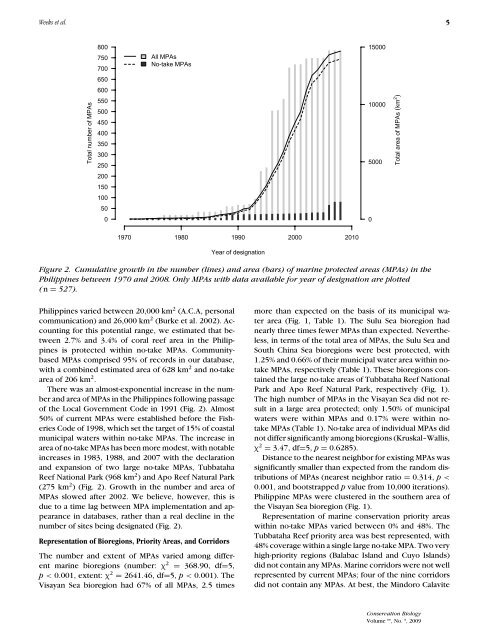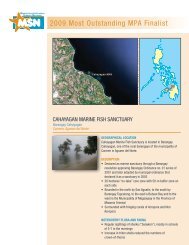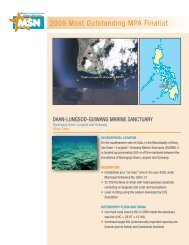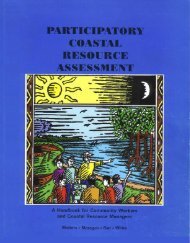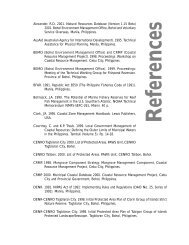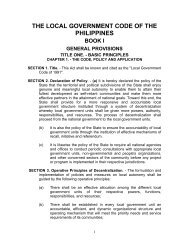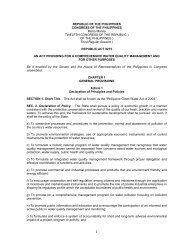Effectiveness of Marine Protected Areas in the Philippines for ...
Effectiveness of Marine Protected Areas in the Philippines for ...
Effectiveness of Marine Protected Areas in the Philippines for ...
You also want an ePaper? Increase the reach of your titles
YUMPU automatically turns print PDFs into web optimized ePapers that Google loves.
Weeks et al. 5<br />
Figure 2. Cumulative growth <strong>in</strong> <strong>the</strong> number (l<strong>in</strong>es) and area (bars) <strong>of</strong> mar<strong>in</strong>e protected areas (MPAs) <strong>in</strong> <strong>the</strong><br />
Philipp<strong>in</strong>es between 1970 and 2008. Only MPAs with data available <strong>for</strong> year <strong>of</strong> designation are plotted<br />
( n = 527).<br />
Philipp<strong>in</strong>es varied between 20,000 km 2 (A.C.A, personal<br />
communication) and 26,000 km 2 (Burke et al. 2002). Account<strong>in</strong>g<br />
<strong>for</strong> this potential range, we estimated that between<br />
2.7% and 3.4% <strong>of</strong> coral reef area <strong>in</strong> <strong>the</strong> Philipp<strong>in</strong>es<br />
is protected with<strong>in</strong> no-take MPAs. Communitybased<br />
MPAs comprised 95% <strong>of</strong> records <strong>in</strong> our database,<br />
with a comb<strong>in</strong>ed estimated area <strong>of</strong> 628 km 2 and no-take<br />
area <strong>of</strong> 206 km 2 .<br />
There was an almost-exponential <strong>in</strong>crease <strong>in</strong> <strong>the</strong> number<br />
and area <strong>of</strong> MPAs <strong>in</strong> <strong>the</strong> Philipp<strong>in</strong>es follow<strong>in</strong>g passage<br />
<strong>of</strong> <strong>the</strong> Local Government Code <strong>in</strong> 1991 (Fig. 2). Almost<br />
50% <strong>of</strong> current MPAs were established be<strong>for</strong>e <strong>the</strong> Fisheries<br />
Code <strong>of</strong> 1998, which set <strong>the</strong> target <strong>of</strong> 15% <strong>of</strong> coastal<br />
municipal waters with<strong>in</strong> no-take MPAs. The <strong>in</strong>crease <strong>in</strong><br />
area <strong>of</strong> no-take MPAs has been more modest, with notable<br />
<strong>in</strong>creases <strong>in</strong> 1983, 1988, and 2007 with <strong>the</strong> declaration<br />
and expansion <strong>of</strong> two large no-take MPAs, Tubbataha<br />
Reef National Park (968 km 2 )andApoReefNaturalPark<br />
(275 km 2 ) (Fig. 2). Growth <strong>in</strong> <strong>the</strong> number and area <strong>of</strong><br />
MPAs slowed after 2002. We believe, however, this is<br />
due to a time lag between MPA implementation and appearance<br />
<strong>in</strong> databases, ra<strong>the</strong>r than a real decl<strong>in</strong>e <strong>in</strong> <strong>the</strong><br />
number <strong>of</strong> sites be<strong>in</strong>g designated (Fig. 2).<br />
Representation <strong>of</strong> Bioregions, Priority <strong>Areas</strong>, and Corridors<br />
The number and extent <strong>of</strong> MPAs varied among different<br />
mar<strong>in</strong>e bioregions (number: χ 2 = 368.90, df=5,<br />
p < 0.001, extent: χ 2 = 2641.46, df=5, p < 0.001). The<br />
Visayan Sea bioregion had 67% <strong>of</strong> all MPAs, 2.5 times<br />
more than expected on <strong>the</strong> basis <strong>of</strong> its municipal water<br />
area (Fig. 1, Table 1). The Sulu Sea bioregion had<br />
nearly three times fewer MPAs than expected. Never<strong>the</strong>less,<br />
<strong>in</strong> terms <strong>of</strong> <strong>the</strong> total area <strong>of</strong> MPAs, <strong>the</strong> Sulu Sea and<br />
South Ch<strong>in</strong>a Sea bioregions were best protected, with<br />
1.25% and 0.66% <strong>of</strong> <strong>the</strong>ir municipal water area with<strong>in</strong> notake<br />
MPAs, respectively (Table 1). These bioregions conta<strong>in</strong>ed<br />
<strong>the</strong> large no-take areas <strong>of</strong> Tubbataha Reef National<br />
Park and Apo Reef Natural Park, respectively (Fig. 1).<br />
The high number <strong>of</strong> MPAs <strong>in</strong> <strong>the</strong> Visayan Sea did not result<br />
<strong>in</strong> a large area protected; only 1.50% <strong>of</strong> municipal<br />
waters were with<strong>in</strong> MPAs and 0.17% were with<strong>in</strong> notake<br />
MPAs (Table 1). No-take area <strong>of</strong> <strong>in</strong>dividual MPAs did<br />
not differ significantly among bioregions (Kruskal–Wallis,<br />
χ 2 = 3.47, df=5, p = 0.6285).<br />
Distance to <strong>the</strong> nearest neighbor <strong>for</strong> exist<strong>in</strong>g MPAs was<br />
significantly smaller than expected from <strong>the</strong> random distributions<br />
<strong>of</strong> MPAs (nearest neighbor ratio = 0.314, p <<br />
0.001, and bootstrapped p value from 10,000 iterations).<br />
Philipp<strong>in</strong>e MPAs were clustered <strong>in</strong> <strong>the</strong> sou<strong>the</strong>rn area <strong>of</strong><br />
<strong>the</strong> Visayan Sea bioregion (Fig. 1).<br />
Representation <strong>of</strong> mar<strong>in</strong>e conservation priority areas<br />
with<strong>in</strong> no-take MPAs varied between 0% and 48%. The<br />
Tubbataha Reef priority area was best represented, with<br />
48% coverage with<strong>in</strong> a s<strong>in</strong>gle large no-take MPA. Two very<br />
high-priority regions (Balabac Island and Cuyo Islands)<br />
did not conta<strong>in</strong> any MPAs. <strong>Mar<strong>in</strong>e</strong> corridors were not well<br />
represented by current MPAs; four <strong>of</strong> <strong>the</strong> n<strong>in</strong>e corridors<br />
did not conta<strong>in</strong> any MPAs. At best, <strong>the</strong> M<strong>in</strong>doro Calavite<br />
Conservation Biology<br />
Volume **, No. *, 2009


